|
We have eight double
rooms and two suites on two floors. The upstairs rooms
are set around an atrium, lush with tropical potted
plants. Our twin-bedded rooms are comfortable and
spacious, furnished in elegant teak. Large windows
look out on to fine views. Each room is fitted with
a capacious wardrobe, a bedside table and couch, a
work-desk and chair, and a telephone with international
calling facilities. Each attached bathroom is equipped
with attractive up-to-date shower units with constant
24-hour hot & cold running. Rooms are air-conditioned
in the summer, and heated during the winter.

TIGER SUITE The Tiger’s
vigor and freedom from fear make it a natural symbol
of strength and power, prerequisites for success in
both spiritual and worldly pursuits. In Tibet, owning
a tiger skin was a sign of spiritual and worldly influence.
There was an unavoidable contradiction in this love
for stripes. Tibetans Buddhists disdain hunting and
killing, and protecting wildlife was a government
policy. This problem was solved with the invention
of the eco-tiger skin in the form of carpets, silk
hangings and other household objects, which decorate
this suite. The dragon suite contains two adjoining
bedrooms– one with a queen bed, and the other with
a twin. It is located on the first floor and has an
attached balcony.

IBEX SUITE The Ibex
is a kind of mountain goat which lives high on the
Tibetan Plateau, often at altitudes over 6000 meters.
Their magnificent curved horns are the largest among
all species of wild goat. In ancient Tibet, ibex were
considered very auspicious, and statues of ibex were
often given to parents who had just given birth as
a blessing for the child. This suite contains two
adjoining bedrooms– both with queen beds. It is located
on the ground floor and has an attached terrace overlooking
the surrounding trees.
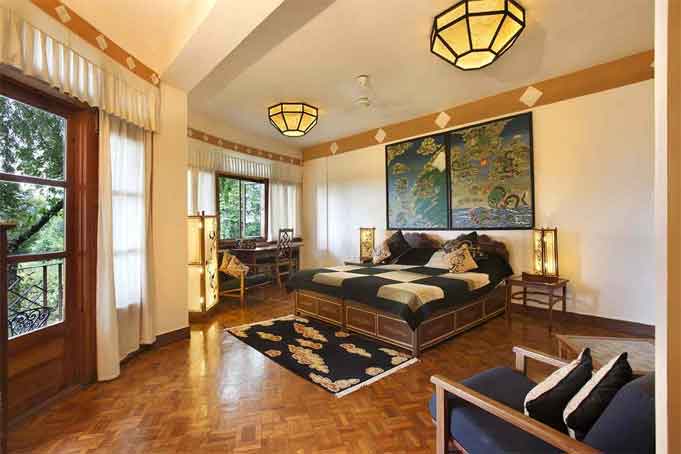
DRAGON SUITE Dragons,
far from being the monsters of European mythology,
are seen in Tibet as real animals, and not at all
evil. They are symbols of power, strength, and good
luck. Water dwelling creatures, dragons control the
weather. Their roar is thunder and they bring rain
by squeezing jewels they carry in their claws. This
suite contains two adjoining bedrooms– one with a
queen bed, and the other with a twin. It is located
on the first floor and has an attached balcony overlooking
the surrounding trees.

PARROT ROOM Vibrant
Indian Ringneck Parrot grace the Norbulingka gardens,
and blend in among the foliage, calling to each other
from the treetops. Both male and female are bright
green, but the male boasts a special pattern around
his neck, pink or black, high-lighted by turquoise
hues. Highly intelligent, they are often kept as pets,
and are know for their wonderful talking skills. Parrots
symbolize communication, courtship, and romantic love.
This superior room is located on the ground floor
and has two twin beds which can be converted into
a king. It also has an attached terrace.
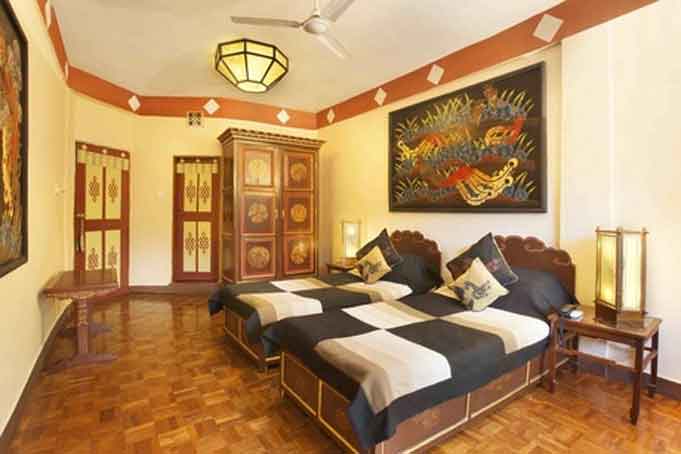
PHOENIX ROOM The
phoenix is a mythical bird, who is believed to live
forever. His body incinerates in a burst of flame,
and from the ashes of his previous body, a new egg
hatches. He is a symbol of eternal life, resurrection,
and transformation and a bearer of good fortune and
prosperity. This superior room is located on the first
floor, and has two twin beds which can be converted
into a king.
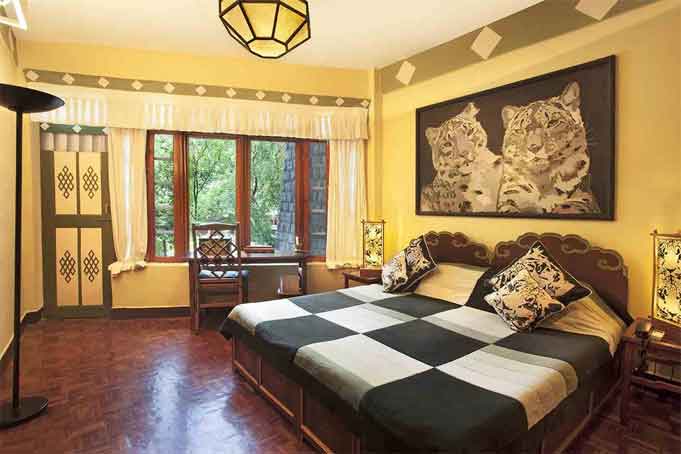
SNOW LEOPARD ROOM
The snow leopard is one of the most beautiful and
rare animals in the world. Living in high altitudes
across Tibet and Central Asia, their coat is thick
and luscious, and their wide, fur-covered feet act
as natural snowshoes. Mountain dwellers, they are
incredible leapers, and can spring up to fifty feet!
The snow leopard is a cherished animal in Tibet. In
one legend, it is said that the great mystic Milarepa
transformed himself into a magnificent snow leopard
in order to find food for himself when his hermitage
was completely cut off from any village due to heavy
snow fall. This superior room is located on the ground
floor, and has two twin beds which can be converted
into a king. It has an attached balcony.

SNOW LION ROOM The
snow lion is a celestial creature who inhabits Tibet’s
snowy peaks, dwelling only in the purest of environments,
undefiled and fearless. His feet never touching the
ground, he is eternally at play, leaping from mountain
peak to mountain peak. His mane is the color of Tibet’s
pristine lakes and his body is as white the snow land
he inhabits. His great roar expresses the sound of
emptiness, the essence of the Buddhist doctrine. The
snow lion is the national animal of Tibet, and also
the symbol of Shakyamuni Buddha. He can be seen gracing
HH the Dalai Lama’s insignia, and a pair hold a place
of honor on the Tibetan flag, bearing the Three Jewels.
This superior room is located on the first floor,
and has two twin beds which can be converted into
a king.

GARUDA ROOM Garudas
are semi-divine creatures that combine a bird’s head,
wings, and feet with a human torso. Described as Kings
of the Sky, Garuda’s wings are said to span many miles.
A single flap can bring hurricane force winds that
darken the sky and blow down houses. They are believed
to be protectors of Buddhism and represent freedom
from fear. This superior room is located on the first
floor, and has two twin beds which can be converted
into a king. It looks out over the surrounding trees
and fields.
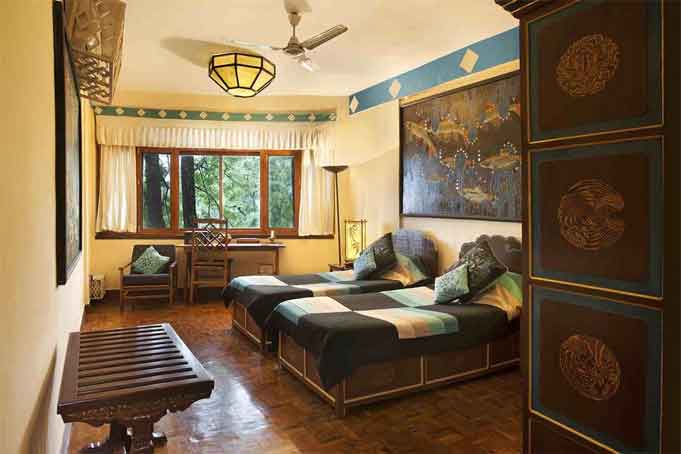
FISH ROOM The fish
is traditionally considered one of the luckiest animals.
He is one of the signs in the Tashi Targye, a collection
of religious symbols, and the most common motifs used
in Tibetan decorative arts. Fish symbolize being free
from the fear of drowning in the ocean of sufferings,
and having the power to move freely and spontaneously
from place to place, just as fish swim freely through
water. This superior room is located on the first
floor and has two twin beds which can be converted
to a king.

SEA MONSTER ROOM
The sea monster, makara in Sanskrit, is a mythical
creature with the jaws of a crocodile, the trunk of
an elephant, the tusks and ears of a wild boar. It
has the darting eyes of a monkey, the scales and flexible
body of a fish, and the swirling tailing feathers
of a peacock. They can often be found at the corners
of temple roofs and represent strength, determination,
and tenacity. This superior room is located on the
ground floor, and has two twin beds which can be converted
into a king. It also has an attached terrace, looking
out on the surrounding trees.
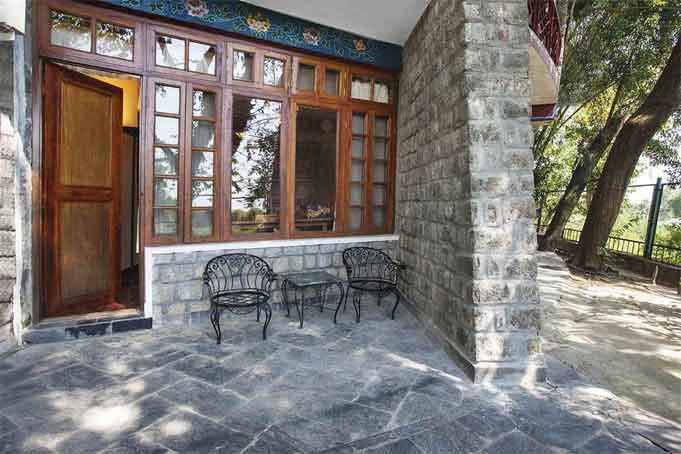
BIRD ROOM The Paradise
Flycatcher is a common sight in the gardens of Norbulingka
and throughout lush Himalayan foothills. The male
is white with a long tail that undulates behind him
as he flies from tree to tree. The female, more compact
and coral red, stands nearby tending to the nest.
This superior room is located on the ground floor,
and has a queen bed. It also has an attached terrace,
looking out on the surrounding trees and fields.
Facilities
The sitting room has a small library and a television
with DVD player. Guest house services include internet
access, room service, laundry, taxis, and private
parking. Norling Café provides a wide range
of meals and snacks that you can enjoy in the Guest
House or the Café. Guests are very welcome
to use the meditation hall, located on the first floor
of the Deden Tsuglagkhang, the temple at the head
of the campus.
|